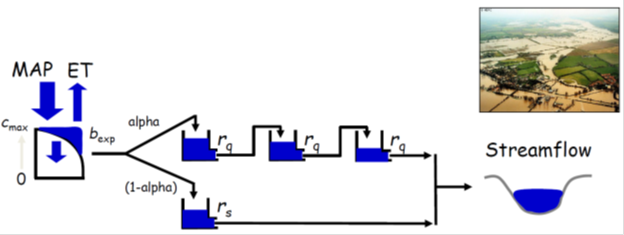Case-Study IV: Bayesian inference of a conceptual watershed model (HYMOD code in C/C++)
In this fifth study, we use the HYMOD conceptual watershed model, a parsimonious rainfall-runoff model whose parameters are thought to vary between watersheds. This model has been used in a numerous studies and has five parameters that need to be specified by the user. Inputs to the model include mean areal precipitation (MAP), and potential evapotranspiration (PET), while the outputs are estimated channel inflow. The HYMOD model has been discussed extensively in many previous papers that study streamflow forecasting and automatic model calibration (Boyle 2000; Wagener et al. 2001; Vrugt et al. 2003). Details of the model can be found therein.
In summary, HYMOD consists of a simple two-parameter rainfall excess model connected with two series of linear reservoirs (three, identical, for the quick and a single reservoir for the slow response) in parallel as a routing component (see Figure 4.01).

Figure 4.01: Conceptual representation of the HYMOD conceptual watershed model
The rainfall excess model is described in detail by Moore (1985, 1999). The model assumes that the soil moisture storage capacity, c, varies across the catchment and, therefore, that the proportion of the catchment with saturated soils varies over time. The spatial variability of the soil moisture capacity is described by the following distribution function
|
(4.01) |
where c(t) is the simulated soil water storage capacity at time t and cmax (mm) and bexp (-) are unknown coefficients.
HYMOD has five different parameters whose values need to be determined from a measured discharge record. The parameters and their prior uncertainty ranges are listed in Table 4.01. This includes cmax (L), the maximum storage capacity in the catchment, bexp (-) the degree of spatial variability of the soil moisture capacity within the catchment, α (-) a coefficient that distributes the flow between the fast and slow-flow reservoirs, and rs (days) and rq (days), the residence time of the slow and fast-flow reservoir reservoirs, respectively. The actual evapotranspiration is equal to its potential value if sufficient soil moisture is available, otherwise it is reduced depending on the soil water status.
Parameter |
Symbol |
Lower |
Upper |
Units |
Maximum interception |
|
10 |
1000 |
mm |
Soil water storage capacity |
|
0 |
2 |
- |
Maximum percolation rate |
|
0 |
1 |
- |
Recession constant slow-flow reservoir |
|
|
|
- |
Recession constant fast-flow reservoir |
|
|
1 |
- |
Table 4.01: Parameters of HYMOD and their prior uncertainty ranges
We use historical data from the Leaf River (1950 km2) watershed in Mississippi in the USA. The data consists of daily MAP (mm/day), PET (mm/day), and streamflow (mm/day) values. A two year data record is used for posterior inference of the HYMOD parameters. This includes the period from January 1, 1952 to September 30, 1954. A multivariate uniform prior distributed is assumed for the parameters using the ranges listed in Table 4.01. The posterior parameter distribution is now determined with DREAM using a simple Gaussian likelihood function
|
(4.02) |
where  and
and  are the observed and simulate discharge record, respectively, n denotes the number of measurements, and |·| denotes the modulus operator (absolute value). The initial population is drawn from the lower and upper ranges listed in Table 4.01 using Latin hypercube sampling. We use N = 10 chains with DREAM and use standard settings for the algorithmic variables.
are the observed and simulate discharge record, respectively, n denotes the number of measurements, and |·| denotes the modulus operator (absolute value). The initial population is drawn from the lower and upper ranges listed in Table 4.01 using Latin hypercube sampling. We use N = 10 chains with DREAM and use standard settings for the algorithmic variables.
Implementation of plugin functions
The complete source code can be found in DREAM SDK - Examples\D3\Drm_Example04\Plugin\Src_Cpp